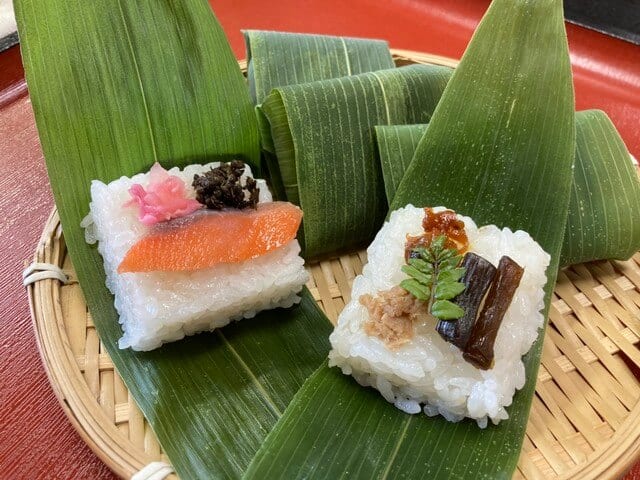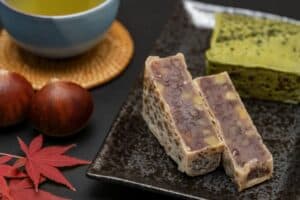Introduction to Sasa Sushi
Sasa Sushi is a traditional food in Japan in which it is a local dish from the Hokuriku region. Likewise, it is a type of sushi in which the sushi rice and sushi seeds are wraps with Kumazasa or bamboo leaves. Sasa Sushi is indeed an indispensable dish for festivals in Hakusan City and the Noto region. Moreover, you can also find this in Nagano and Niigata prefectures. Additionally, the locals topped it with sushi rice and other ingredients or condiments.
Thus, you can find Sasa Sushi in the prefectures in the Hokuriku region. Accordingly, the Hokuriku region includes the four prefectures of Ishikawa, Fukui, Niigata, and Toyama. Along with Sasa sushi, there are other types of sushi, as well as, Bekko Sushi and Edomae Sushi that are specialties from Tokyo. Now, as we go along with this article, we will get to know what Sasa Sushi is.
Etymology

Everyone is curious why the Japanese call this Sasa Sushi. Basically, it has two root words; “Sasa” (笹) and “Sushi” (寿司). Accordingly, Sasa (笹) in Japanese means bamboo grass and Sushi (寿司) means fermented rice which was used for preserving fish. Hence, Sasa Sushi means sushi wrapped in bamboo grass.
What is Sasa Sushi?

Sasa Sushi is a traditional food from Ishikawa prefecture Japan. It is in fact, a type of Oshizushi in which the sushi rice and sushi seeds are wraps with Kumazasa or bamboo leaves. Additionally, in Nagano and Niigata prefecture, locals wrapped it with bamboo leaves and topped it with ingredients or condiments. As well as Kakinoha Sushi, Sasa Sushi is a type of Oshizushi where you can enjoy the scent of each season and with the rich scent of bamboo leaves.
In fact, sasa sushi is an indispensable dish for festivals in Hakusan City and the Noto region. Moreover, locals made this by wrapping the sushi rice and fish in bamboo strips and letting them rest overnight. Furthermore, there is a variety of ingredients, from bite-sized vinegared rice placed on Kumazasa to lid-sized vinegared rice, edible wild plants, field products, and salmon loosened meat. Hence, the balance between the refreshing aroma of bamboo grass, vinegared rice, and plant-based ingredients is exquisite.
Origin of Sasa Sushi

“Sasa Sushi” was born from the inspiration of the founder Takayuki Kajitani. The beginning was to replace the rice cake with rice, using the bamboo rice cake sold. However, since then, flexible ideas have created hit products one after another and have been built up with innovative management strategies.
The history of Sasa sushi began when the Uesugi group of the Tenpo era invaded Kaga Noto and the people in the foothills of Hakusan made and ate “Sasa sushi” as a preserved food for the military supplies. After that, common people made “Oshizushi ” at the “Horai Festival” in Tsurugi, Hakusan City, and people who enjoyed the festival loved this.
They call it “festival sushi” because they serve it at the time of the festival, and it became a local culture until the wooden frame pusher used to make pressed sushi at home became one of the wedding tools. Sasa-sushi, a pressed sushi and “Sasa-mochi” from a candy store, has been created so many can eat it at any time, and it has become popular.
Differences in Sasa Sushi in prefectures
Ishikawa and Toyama prefectures
The Sasa Sushi in Ishikawa and Toyama prefectures is a type of pressed sushi wrapping two pieces of bamboo grass and applying pressure with heavy stones. The ingredients are generally salmon, trout, dorado, and sea bream, and some use fried tofu. Locals add lemon, ginger, Japanese pepper leaves, etc. to the condiments to add an accent to both the appearance and taste.
Nagano and Niigata Prefectures
Locals in Nagano and Niigata prefectures make Sasa Sushi by placing vinegared rice on top of bamboo leaves. Additionally, they add ingredients and condiments on top of it. However, in some areas, it seems that locals mixed some vinegared rice with ingredients. The ingredients are mainly wild plants such as bracken and bamboo shoots, however, they also used hijiki seaweed, fried tofu, carrots, walnuts, etc. Japanese used red pickled ginger as a condiment, and it is a sushi that is popular for its simple taste.
Sasa Sushi Recipe
The menu for Sasa sushi depends on the region. Thus, ingredients needed are rice, water, egg, rice vinegar, kelp, sugar, salt, ginger, lemon, any fish meat or vegetables. The fish meat can either be salmon, tuna, amberjack, mackerel, etc.
How to make Sasa Sushi?
Wash white rice and glutinous rice and soak them in water for 1 to 2 hours. Rinse them and leave them for 30 minutes.
Combining vinegar, sugar, salt, and heating it to dissolve salt and sugar. (You may use sushi vinegar)
Put kelp in rice and cook it in a sushi tub. You can also sprinkle it with seasoned vinegar and cover it with a wet cloth to cool.
Cut the fish into three pieces, salt it, and leave it for 2-3 hours. Then, you can wash it with water, soak it in vinegar with ginger for 30 minutes to 1 hour, and cut it into pieces.
Shred ginger and soak it in water. Cut the lemon into chopped pieces and rinse it with water. Cut the warp or bamboo leaves according to the mold.
Firstly, wet the sushi frame with water, spread the warped wood, and line up the lemon and fish. Then, spread or press the sushi rice, put the seaweed, sakura shrimp, and needle the ginger on it to make one more warp wood. Repeat in the same way.
Cut it into pieces and serve it on a plate.
Do you eat the leaves on the Sasa Sushi?

Do you eat the leaves or just peel back the layer and eat the contents inside? This is the dilemma that many people face when trying food that is unfamiliar to them on travels or at a local restaurant. Thus, grape, bamboo, lotus, and banana are the more common leaves. Consequently, whichever leaf you used to wrap food, the leaves are cleaned and washed. They are soaked for from an hour before use or up to overnight before wrapping so that folding is easier and cracking is avoided. You can buy leaves fresh, dried, or frozen.
What is the essence of wrapping the food?

Wrapped food indeed adds the element of anticipation. Thus, flavors are trapped and infuse the food. It also additionally protect the food from flames or losing shape and keep in the heat, plus the outer wrappings come from nature.
What are the health benefits of eating Sushi?

Sushi is loaded with various nutrients as it is with rice, fresh fish, and crunchy vegetables. The seafood in sushi contains high content of Omega-3s and selenium along with various minerals as well as vitamins. In addition to that, it is also rich in sodium content. It helps to maintain weight, build muscles, boost energy, enhance immunity, supports digestion, and others.
The Art of Eating Sushi

For a first-timer, the art of eating sushi can be a formidable task. But the tricks are fairly simple if you don’t let the whole presentation of it get to you. Sushi is typical with three condiments on the side – soy sauce, a dollop of wasabi (a dry green paste), and gari (pickled ginger). Traditionally, locals consumed sushi with their fingers but some may use chopsticks. Thus, this is also why you ought to wash your hands before you start. In the case of a nigiri, you need to turn the sushi around (rice up, fish down), lightly dip it into the soy making sure that you don’t dip the whole thing in, and eat it. You can also do is mix the wasabi in the soy and then dip the sushi into it. Usually, chefs smear a little bit of wasabi between the fish and the rice.
Recommended Sasa Sushi Restaurants
Shibaju Shinosato

Starting with Sasa-sushi, Shibaju Shinosato makes Shiba-sushi products. As you know, pressed sushi wrapped in bamboo leaves is almost always sold at supermarkets in the prefecture. They also serve yellowtail sasa sushi. Here you can also learn about the history of Shibaju, buy various products made by Shibaju, and enjoy the deliciousness of Shibaju on the spot. It is a facility like a mini theme park.
Shibaju Kanazawa Hyakubangai store

Shibaju Kanazawa Hyakubangai store serves Sasa Sushi that does not contain the standard items but a luxurious one. The fish meat the shop wrapped in bamboo grass can either be red salmon, yellowtail, conger eel, red sea bream, etc. When you open the sushi, you can smell the scent of bamboo grass. The fish meat inside is plump. The sasa sushi you eat here is like the sasa sushi you eat at the time of the festival.
Ippukudokoro Ohagiya

At this time of year, the specialties here that locals worship are rice sushi, sasa-sushi, kusa mochi, and sake bun kuzumochi. Among them, Sasa-sushi remained. In fact, Tsurugi’s Sasa-sushi is called “Horai-zushi”. For sushi rice made with Koshihikari from Hakusan, the shop wrapped it in bamboo grass and put sakura shrimp, black sesame, trout, and ginger on top. The scent of bamboo grass is exquisite.
Shibaju Al Plaza Kanazawa

Although the ingredients used in the shop’s Sasa sushi are too small for the volume of the rice, the conger eel was the delicious one. Only conger eel is not vinegared rice, but soy sauce-flavored rice. That makes it taste good. It was perfect to put it on the menu for the shop’s breakfast.
Shibazushi Aeon Okyozuka

At Shibazushi Aeon Okyozuka store, they serve two kinds of Sasa Sushi; sea bream and salmon. Hence, the sasa-sushi sea bream is with bamboo grass, sushi rice, sea bream and mackerel, and kelp. Consequently, the sasa-sushi salmon is with sushi rice, salmon, and lemon. Both are sushi rice with a moderate taste. In summer, sushi may be better than rice balls, and bamboo grass has a bactericidal effect, so it’s good.
Conclusion

Overall, Sushi is a good example of popular rice-based food. In fact, the word “sushi” means the rice, not the fish. Sushi originated in Japan and has become a part of more global food culture. It is for important scenes such as local athletic meet, neighborhood association, entrance ceremony, graduation ceremony, and a little important time. A long time ago, it was a rule for families to make a large amount of food before an event and share it with their neighbors on the day of the event. Locals eat this during the New Year and ceremonial occasions, as well as during the spring and autumn festivals. It was passed down from generation to generation.
















Comments